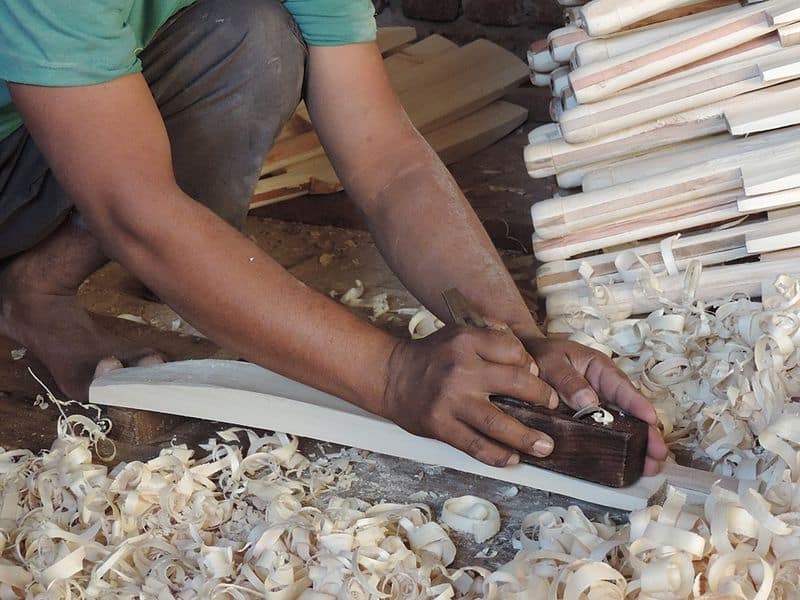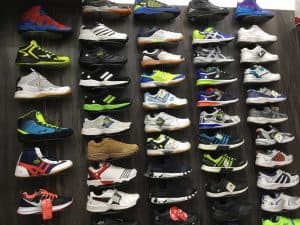Every time MS Dhoni hammers the ball out of the boundary with his helicopter shot, workers at a medium-sized sports manufacturing unit in Jalandhar have an extra reason to cheer. For theirs are the hands that crafted the bat Dhoni has been using over the years.
“Our bats are also being used by Chris Gayle, Michael Clarke, deVilliers among others. Sachin Tendulkar too used our bats,” says Jyoti Sharma, owner of Spartan Sports, with a hint of pride. “Dhoni’s bat is made of English Cleft, a special type of willow wood imported from England. It has a more pronounced curve than ordinary bats, keeping in view his penchant for playing unorthodox shots. Dhoni’s bat is of medium weight (2.9 pounds), while Chris Gayle uses the firm’s 3.6 pound bat, the heaviest bat used by any batsman.” Spartan Sports also manufactures football, basketball, net ball, cricket ball, rugby ball, fitness equipment, and accessories among others.
Details such as these are common knowledge among sports goods makers in Jalandhar, India’s oldest and largest sports goods manufacturing hub. However, in recent years, the industry here has been on a downturn. In its heyday, the industry gave direct and indirect employment to 1.25 lakh workers, which has been reduced to 60,000 over the last 10 years. “We have seen around 50 per cent decline in the overall output,” says Sharma. “There is no work left in the Indian market. Sports goods carry a GST of 18%. How can the average player afford bats worth Rs 15,000 to Rs 40,000?”
The major part of the cricket bat manufacturing process is done by hand. In recent times, a part of the process has been automated with the use of sophisticated Computer Aided Manufacturing techniques, which gives a better quality and finish. The process involves selection and cutting of willow, pressing, handle fitting, extra wood removal and giving the bat its final shape, followed by grip fitting on handle.

Cricket Bat being made by hand in a sports goods manufacturing unit. Pic: Amit Kapil/Wikimedia Commons (CC BY-SA 4.0)
The GST shock
The implementation of GST in 2017 had sent shock waves through the Jalandhar sports industry as a majority of the units are in the unorganized sector, and are finding it tough to comply with the increased taxes. Sharma gives the example of the standard cricket kit bag costing Rs 2000. “Now the kids have to pay Rs 360 as tax on a bag. How are they going to afford other equipment?” Also, the government has withdrawn all incentives earlier extended to exporters. “The government has written off loans worth thousands of crores given to a few individuals, whereas we do not get finance even of Rs 1 crore for our new projects.”
Sharma does see the removal of Article 370 and Section 35A in Jammu and Kashmir as a positive development, though. “Earlier it was not easy to get Kashmir Cleft wood. We used to get it through the Lakhanpur border post and it involved a lot of irregularities. Now we expect it will be easier to source this wood from Kashmir.”
The sports goods industry in Jalandhar traces its origins to Sialkot in pre-Independence India, thanks to the British penchant for sports. It began with manufacture of cricket equipment and gradually expanded to cover games like hockey and football. Even today, the Commonwealth countries, particularly Britain and Australia remain its largest trading partners, besides the USA.
After Independence, a number of families engaged in manufacturing of sports goods, essentially a small scale and cottage industry, migrated to India and set up base in and around Jalandhar, which at one time was contributing almost 8o per cent of the sports goods manufactured in India. Of late, this leadership position has been challenged successfully by Meerut, a sleepy UP city located at an hour’s distance from Delhi.
For the 1200 small and medium sports goods units in Jalandhar, it appears to be a case of missed opportunity. Sports goods manufacture is labour intensive, with production of standardised products outsourced to contracted labour, who often use their own premises to produce the finished goods. In its heyday, Jalandhar was exporting its products including footballs, rugby balls, sports shoes and accessories, cricket bats, tennis balls, and cricket balls to global majors such as Nike, Reebok, Adidas, Puma, Slazenger, and Webb Ellis. It exported sports goods to over 130 countries.
The Chinese invasion
But then came the competition from across the seas. While cheap Chinese imports flooded the domestic market, in the international markets the Jalandhar units have been badly hit by foreign manufacturers ability to lower manufacturing costs and the use of sophisticated technology in many products, something the Jalandhar units have been unable to cope with.
To begin with, the Chinese juggernaut steamrolled the Jalandhar manufacturers when it came to competing in its mainstay, inflatables such as footballs, basketballs and rugby balls. The Chinese could produce a football for USD 1.50 compared to the USD 2.0 it took in Jalandhar. Compared to its foreign counterparts, the Jalandhar industry did not receive any incentives from the state or central government. For instance, Pakistan declared its Sialkot hub as a zero-tax zone, enabling it to emerge as the prime manufacturer of hockey sticks and soccer balls. And the Taiwanese have taken away a major pie of the shuttlecock business.
From a high of 90 per cent export market share in its heyday in the 80s and 90s, Jalandhar’s market share now is 35 per cent (Meerut has 45 per cent). Indian sports goods exports earned Rs 1079.4 crore in 2017-18. Overall, the sports goods industry in India has a turnover of Rs 1800 crore, with 60 per cent of it from exports. As per online statistics portal Statista.com, the market volume of sports goods in India is USD 685 million, compared to USD 20,720 million of China, which is the global leader in this segment (India is at number 7).

The market volume of sports goods in India is USD 685 million, placing it at 7th position in the global market. China is at the top. Pic: Anand Sports Industries
The Jalandhar sports manufacturers have failed to grow out of the traditional family owned business model. Says Raghunath Singh Rana, Founder and Managing Partner of Ranson Sports, one of the leading units in the city: “Internationally we are maintaining our grip but the domestic market is down. Meerut has grown because it has ventured into new fields – training, educational sports products, track and field, and agility products. They have beaten the Chinese in some of these areas.”
On the way forward for units like his, Rana says the industry needs to modernise, and quickly. “We need to infuse new technology into the industry, strengthen our product and development. The segments where we do not have new technology will fade out sooner or later.”
The way forward
Chairman of Sports Goods Manufacturers and Exports Association Ajaya Mahajan says that the stagnant growth has been more on account of the cyclical nature of the business. Talking to Citizen Matters on a range of issues, he said: “The Jalandhar sports industry still reigns supreme. The Meerut phenomenon is a relatively new one. In the 80s, a number of families from Jalandhar migrated to Meerut and started fresh and grew fast.”
Regarding international competition he said the Central government has failed to react. “The industry in Jalandhar hasn’t got any incentive to corporatize. Pakistan has taken the lead in hockey and soccer balls because their currency has devaluated to half of ours. Buyers would be more than happy to buy from us at a comparative price. The industry in Jalandhar has matured to the extent that it is now seen as more of a supplier of products.” Mahajan’s company, Uma International, supplies rugby balls and equipment to some of the leading rugby clubs and national teams across the world.
Regarding lack of innovation in the industry, Ajaya Mahajan said that it was up to the individual units. “In India, we have a herd mentality. Everyone wants to latch on to a successful product till all its potential is lost. Yet, Jalandhar has many companies investing in innovation such as laying out of modern field hockey units. At present, demand has been impacted because globally markets are not in the best of health. Sports is still perceived as a luxury in India, and the demand therefore depends on the economic cycle to a large extent”.
On competition from China, he said “China enters any field with full state support, huge capital, and jobs for its unemployed. In India the interest rates are very high. The government needs to address our basic issues. For instance, sports hubs like Jalandhar and Meerut are landlocked, facing transportation issues.”
Jalandhar Cantonment MLA Pargat Singh, a former India hockey captain, admitted that the sports goods industry in his city is facing problems. “We need to take steps to enable the industry to grow,” said Pargat. “As a sportsperson, I feel we need to make a collective effort to see that the problems are solved. As of now the matter is with the sports minister who needs to come up with effective steps so that the industry does not suffer”.
Hardeep Singh, an industry associate, addresses more fundamental issues. “We have the DNA to emerge as number one in the world. However, the government must provide proactive support—-exposure to new technologies and programmes for rural women to step out and work in small industries. Presently, the majority of labour in Jalandhar comes from UP and Bihar. It is imperative to be competitive both on cost and technology to combat the price war from thriving traditional industry in Bangladesh, Pakistan and the technologically advanced Taiwan and China.”
Yet, Punjab sports minister Gurmeet Singh Sodhi says the Jalandhar sports industry representatives are not approaching him with concrete ideas. “I had gone to them last year, but they need more clarity,” said Sodhi. “If they have any suggestion through which they will benefit, we will certainly take it up. That’s what we are sitting here for. As far as taxation is concerned, Punjab government has not imposed any new taxes on the industry. The taxes are all from the Central government. Regarding technology upgradation, they need to come up with a firm proposal and we will do it”.
Perhaps the sports minister can, for a start, think seriously of Hardeep Singh’s suggestions: setting up of a Special Exports Zone (SEZ) for Jalandhar, a sports technology institute, and sops for leather cottage industry.